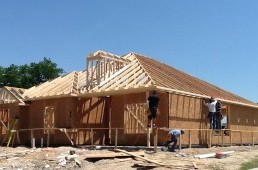
March 4, 2022 | by Michael Wilt
Categories: Affordable Housing, Construction
The cost to construct a home is largely determined by adding up the cost of land, materials, and labor required to build it. In this entry, we're taking a closer look at the state of the construction labor market, how it impacts housing affordability, and what can be done.
Last November, the Home Builders Institute (HBI) released its Fall 2021 Construction Labor Market Report that provided alarming data on the current state of the market and what's needed to address it. The primary takeaway is that the construction industry needs to hire 2.2 million more workers over the next three years to meet the demand for housing growth across the country. That's approximately 61,000 new hires per month.
These eye-catching numbers prompted HBI President and CEO Ed Brady to note that "the construction worker shortage has reached crisis level."
Here are three additional takeaways from the report as summarized by the National Association of Home Builders:
The primary impact of a labor shortage is a reduction in the supply of housing which drives up prices. The Federal Reserve Bank of Dallas spoke to this in an article published last summer. The piece cites Austin as an example where low inventory sent median sales prices skyrocketing from $331,000 in May 2020 to $448,000 in May 2021. But Austin isn't an outlier as the "median sales price in all major Texas metros is at or near a record high."
The article notes that labor shortages aren't the only reason for low inventory and higher housing prices. Longer building times, escalating costs, and a shortage of lots and materials are contributing factors. The combined effect is that builders are restricting home sales and thus reducing inventory.
The HBI report recommends steps to address the labor shortage, and we've highlighted a few here:
Locally, the Texas Builders Foundation is attempting to do their part to recruit future generations into construction-related trades by providing scholarships to students pursuing residential construction-related trade certifications or degrees. The foundation is currently accepting applications for scholarships for the fall 2022 semester, and applications are due April 29th. Click here for a link to the application and instructions.
On the House blog posts are meant to provide general information on various housing-related issues, research and programs. We are not liable for any errors or inaccuracies in the information provided by blog sources. Furthermore, this blog is not legal advice and should not be used as a substitute for legal advice from a licensed professional attorney.
TSAHC reviews all blog comments before they are posted to ensure a positive experience for our online community. Off-topic comments; hostile, derogatory or deliberately insulting comments; and comments specifically promoting goods and services will not be posted.
Approved comments will be published in their entirety. Personal information will not be removed unless it pertains to someone other than the person submitting the comment. For more information, please see our Comment Posting Guidelines.
To remove a previously submitted and published comment, please contact Anna Orendain at [email protected].
If you have a question regarding any of TSAHC's programs, please contact us.

This blog post delves into a critical issue that affects housing supply and affordability: the impact of the construction labor market. It provides a comprehensive analysis of the relationship between labor availability, construction costs, and the overall housing market.